2018 Advanced Studies Institute Program
2018 Projects and Teams
Mentor: David Mascareñas (Engineering Institute)
Students: Matthew Krebs, Jameson Tockstein
Scenario Statement: Assume the United States is working to develop a bi-lateral treaty with China limiting the use of artificial intelligence (AI) in military applications while protecting commercial interests in the civilian applications.
The military applications of artificial intelligence may create significant threats that the United States is interested in controlling. The civilian applications of artificial intelligence have significant benefits that the United States is interested in exploiting. There are commercial advantages to not sharing the details behind specific advances in artificial intelligence. The focus of this project is not on the applications of artificial intelligence (AI), but rather on building a fundamental framework for thinking about AI from an arms control/treaty verification standpoint.
US Government Agency stakeholders are Department of State, Department of Defense, and Department of Energy/National Nuclear Security Administration Office of Defense Nuclear Nonproliferation will have interest in this work.
Questions to answer in your proposal
- Are the differences between civilian and military applications such that meaningful distinctions can be drawn?
- How can an artificial intelligence tool be evaluated for its actual purpose?
- Can an AI tool be evaluated without revealing proprietary information?
- How would you protect the proprietary information?
Other questions to consider
- What are the signature associated with the development and use of AI?
- How do you quantifiably characterize what type of AI someone is building and what it might be capable of doing?
- How will cyber-physical security measures affect our ability to characterize AI?
- How do you know what level of AI a given device, robot, or facility has?
- What are the signatures that someone is developing or using AI?
- How does information/control theory/formal methods/cyber-security enter into this question?
- Also, for cyber-physical systems, how do you quantitatively characterize the intelligence/impact of a given AI and the actuators that it has at its disposal?
Student Bios
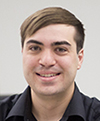 Matthew Krebs — I am a senior studying Computer Science at Lewis University. I interned at Los Alamos National Laboratory for four months working on building a smart nuclear infrastructure using augmented reality. I have been interning at Argonne National Laboratory for the past year working with robotics regarding AR/VR, human robot interaction, and artificial intelligence. I designed, developed, and implemented SDK for operating a ROS based robot for decommissioning of nuclear reactors.
Matthew Krebs — I am a senior studying Computer Science at Lewis University. I interned at Los Alamos National Laboratory for four months working on building a smart nuclear infrastructure using augmented reality. I have been interning at Argonne National Laboratory for the past year working with robotics regarding AR/VR, human robot interaction, and artificial intelligence. I designed, developed, and implemented SDK for operating a ROS based robot for decommissioning of nuclear reactors.
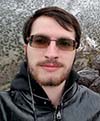 Jameson Tockstein - I earned by B. S. in Physics with a minor in Mathematics from Wayne State University in 2017.
Jameson Tockstein - I earned by B. S. in Physics with a minor in Mathematics from Wayne State University in 2017.
Mentor: Harshini Mukundan (Chemistry Division)
Students: Michaline Albright, Matthew Searle, Kimberly Stevens
Scenario Statement: Assume the United States troops are deployed in a remote location (Iraq, Syria, a submarine) and there is an outbreak of a gastrointestinal disease that is quite infectious and antibiotics are in short stock.
Remote and isolated locations pose a specific set of constraints on solving basic healthcare needs for troops. These locations typically have few resources and are power limited. They will have minimal healthcare experts or laboratory resources. Space for equipment and supplies can be limited.
US Government Agency stakeholders are Department of Defense, and Department of Health and Human Services.
Questions to answer in your proposal
- How do we determine if the infection is bacterial or viral?
- How do we monitor prognosis?
- How do we implement sanitary or quarantine measures?
Other questions to consider
- What would be the sensitivity and specificity minimally required for such a diagnostic?
- How will the biological sample be determined?
- What are the sources of non specific interaction and can they be minimized? How?
Is multiplexing required? How many signatures? What throughput?
Student Bios
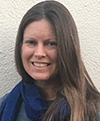 Michaeline Albright — I am a postdoc in B-11 at Los Alamos National Laboratory, where my research focus is in environmental microbiology. I graduated with a Ph.D. in Ecology and Evolutionary Biology in 2017 from the University of California Irvine. I first became fascinated in microbes when I learned about their amazing metabolic diversity; different types of microbes can eat everything from dead plants to toxic metals. Broadly, I am interested in the connections between microbial diversity and biogeochemical cycling.
Michaeline Albright — I am a postdoc in B-11 at Los Alamos National Laboratory, where my research focus is in environmental microbiology. I graduated with a Ph.D. in Ecology and Evolutionary Biology in 2017 from the University of California Irvine. I first became fascinated in microbes when I learned about their amazing metabolic diversity; different types of microbes can eat everything from dead plants to toxic metals. Broadly, I am interested in the connections between microbial diversity and biogeochemical cycling.
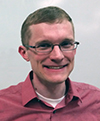 Matthew Searle — I am a PhD candidate in Mechanical Engineering at Brigham Young University and my dissertation topic is heat transfer at superhydrophobic surfaces. As part of my dissertation, I modeled impinging jets and experimentally explored pool boiling. Long term, I would like to improve energy conversion systems by optimizing heat and mass transfer. Outside the lab, I enjoy skiing, hiking, and mountain biking. When I have a free moment, I enjoy reading historical non-fiction. My favorite book is John Adams by David McCullough.
Matthew Searle — I am a PhD candidate in Mechanical Engineering at Brigham Young University and my dissertation topic is heat transfer at superhydrophobic surfaces. As part of my dissertation, I modeled impinging jets and experimentally explored pool boiling. Long term, I would like to improve energy conversion systems by optimizing heat and mass transfer. Outside the lab, I enjoy skiing, hiking, and mountain biking. When I have a free moment, I enjoy reading historical non-fiction. My favorite book is John Adams by David McCullough.
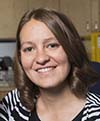 Kimberly Stevens — I received B.S. and M.S. degrees from Brigham Young University in Mechanical Engineering, where I am currently working to complete a Ph.D. I spent the summer of 2016 at the Air Force Research Lab researching performance variability in oscillating heat pipes. My Master's research involved the fluid-structure interactions of vocal folds, while her current research involves fluid and thermal transport on superhydrophobic surfaces. Specifically, I'm is interested in using superhydrophobic surfaces to improve rates of thermal transport during condensation. Outside of research, I enjoy distance-running, rock climbing, hanging hammocks in unusual places, and introducing those hobbies to others.
Kimberly Stevens — I received B.S. and M.S. degrees from Brigham Young University in Mechanical Engineering, where I am currently working to complete a Ph.D. I spent the summer of 2016 at the Air Force Research Lab researching performance variability in oscillating heat pipes. My Master's research involved the fluid-structure interactions of vocal folds, while her current research involves fluid and thermal transport on superhydrophobic surfaces. Specifically, I'm is interested in using superhydrophobic surfaces to improve rates of thermal transport during condensation. Outside of research, I enjoy distance-running, rock climbing, hanging hammocks in unusual places, and introducing those hobbies to others.
Mentor: Chuck Farrar (Engineering Institute)
Students: Matt Adams, Robert Locke, John Sherwood
Scenario Statement: Assume there is an earthquake in Los Angeles and a hurricane in Miami within a few hours of each other. Your job is to provide draft damage assessment reports for the metro areas to the Federal Emergency Management Agency and local governments within 12 hours of the events. You are required to provide updates to your reports every 24 hours for 1 week after the events.
These assessments must include building structures (office, residential, manufacturing) and lifeline systems (transportation (land (road & rail), sea ports and airports), communications, power, water, sewer, emergency response (fire, police, hospitals).
US Government Agency stakeholders are Department of Defense and Federal Emergency Management Agency in the Department of Homeland Security. State and local governments and private companies are also interested in this type of technology.
Questions to answer in your proposal
- Can a new more quantifiable approach to rapid wide-area condition assessment be developed to better address the four factors listed above as well as validate the loss assessment analytical tools?
- What new sensing approaches can be developed to improve the assessment process?
- Can active sensing (using some form of actuation as well as sensing) be incorporated into assessment process?
- How does one integrate and interrogate multi-source data to improve the assessment process?
Can “damage” assessment approaches from other areas (hacker intrusions, epidemic outbreaks) be adopted to this infrastructure assessment process?
Student Bios
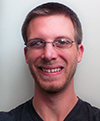
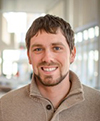 Robert Locke — I am a doctoral student studying Structural Engineering at Clemson University, Clemson, SC. I received my Bachelor’s (2015) and Master’s (2017) degrees at Clemson University, all while being a first generation college student. My research focuses on resilient interconnected infrastructure systems. I am currently analyzing dynamic signals obtained from accelerometers attached to vehicles to detect damage in bridge structures. I am also developing a generally applicable approach for quantifying the flexibility of engineering model during a calibration campaign. When not conducting research, I like to spend my time at the gym or playing sports. If I cannot get outside, I spend my time watching Netflix or playing board games with my friends. My purpose for attending the Institute is to further develop my proposal writing skills and expand my professional network.
Robert Locke — I am a doctoral student studying Structural Engineering at Clemson University, Clemson, SC. I received my Bachelor’s (2015) and Master’s (2017) degrees at Clemson University, all while being a first generation college student. My research focuses on resilient interconnected infrastructure systems. I am currently analyzing dynamic signals obtained from accelerometers attached to vehicles to detect damage in bridge structures. I am also developing a generally applicable approach for quantifying the flexibility of engineering model during a calibration campaign. When not conducting research, I like to spend my time at the gym or playing sports. If I cannot get outside, I spend my time watching Netflix or playing board games with my friends. My purpose for attending the Institute is to further develop my proposal writing skills and expand my professional network.
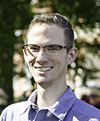
John Sherwood — I am a PhD Candidate in Environmental Engineering & Earth Science at Clemson University and a recipient of the National Science Foundation’s Graduate Research Fellowship. Currently, I am researching Agent-Based Modeling of biophysical economics - the interconnections between energy, economics, and the environment. Specifically, I am building a model of resource-based technological evolution, to determine the feasibility (from technical and economic perspectives) and side-effects of shifting from fossil fuels to renewable resources. Outside of research, I enjoy mountain biking, rock climbing, and photography.
Mentor: David DeCroix
Students: Matthew Humphries, Edward Rojas, Bryan Zeck
Scenario Statement: A small asteroid, a bolide, has entered the earth’s atmosphere. We need to quickly be able to assess its size, composition and trajectory of the object. You can use any number of remote sensing methods, to include but not limited to, radiofrequency, optical, infrared, and infrasound techniques, which could be airborne, ground- or space-based.
US Government Agency stakeholders will have interest in this work: NASA, Department of Defense, the Department of Energy/National Nuclear Security Administration, and the Office of the Director of National Intelligence.
Questions to answer in your proposal
- What are the physical mechanisms that govern radiofrequency, optical and infrared emission of bolides?
- What are the governing principles (equations) and how are they coupled?
- How does the composition of the bolide effect the signatures?
- What computational methods exist at LANL, in academia, or commercially, to solve these equations?
- What experiments could be performed to investigate the individual mechanisms?
- What kinds of instrumentation could be used to detect these signatures in the lab?
- What kinds of instruments could be deployed to detect actual bolides?
Other questions to consider
- What technical disciplines and skills are required in this multidisciplinary problem?
- Regarding computational methods, would you propose solving each phenomena individually and loosely coupling the codes? What would an integrated computational approach involve? What computational resources are required?
- What is the dominate physical mechanism for RF emission? Optical? Infrared?
What are the interactions between the plasma generated by the atmospheric interaction of a hypervelocity body versus the ablation of the bolide itself
Student Bios
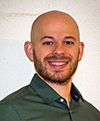 Matthew Humphries – I am a 4th year Ph.D. candidate at the University of Arizona studying inorganic chemistry. I explore the electronic structure and function of dimetal paddlewheel complexes through synthesis, UV-Photoelectron Spectroscopy, and electrochemistry. These complexes are some of the most reactive molecules known! Outside of my studies, I enjoy hiking, backpacking, and cycling.
Matthew Humphries – I am a 4th year Ph.D. candidate at the University of Arizona studying inorganic chemistry. I explore the electronic structure and function of dimetal paddlewheel complexes through synthesis, UV-Photoelectron Spectroscopy, and electrochemistry. These complexes are some of the most reactive molecules known! Outside of my studies, I enjoy hiking, backpacking, and cycling.
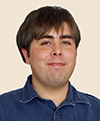 Edward Rojas – I am a PhD. student preparing for my comprehensive exam at New Mexico State University studying Mechanical Engineering with a minor in Mathematics. I am a teaching assistant mentoring undergraduate students in their senior design classes and have been mentoring groups for nearly three years; I assist in all stages of project development from initial designing to prototype and final design testing and analysis. My research focuses on non linear nano energy harvesting with a focus on flexoelectric incorporation of current piezoelectric models with new models under investigation; I also investigate material parameters using molecular dynamic simulations. I enjoy watching movies, playing video games and keeping up with the NBA.
Edward Rojas – I am a PhD. student preparing for my comprehensive exam at New Mexico State University studying Mechanical Engineering with a minor in Mathematics. I am a teaching assistant mentoring undergraduate students in their senior design classes and have been mentoring groups for nearly three years; I assist in all stages of project development from initial designing to prototype and final design testing and analysis. My research focuses on non linear nano energy harvesting with a focus on flexoelectric incorporation of current piezoelectric models with new models under investigation; I also investigate material parameters using molecular dynamic simulations. I enjoy watching movies, playing video games and keeping up with the NBA.

Bryan Zeck – I am a graduate student in the Nuclear Physics group at North Carolina State University, currently preparing my dissertation which focuses on angular correlations and spectral distortions in neutron and nuclear beta decay. I have worked at the Ultracold Neutron (UCN) Facility at the Los Alamos Neutron Science Center (LANSCE) for the past 7 years, and will defend my thesis in the summer of 2018. When I am not writing, I spend my time with my wife, Carrie, and my 3-year-old son, Ethan.
Signature Presentations
- Michelle DeCroix – An Introduction to the Science of Signatures
- Kaelyn Skye Badura – Tech Transfer and Intellectual Property
- Harshini Mukundan – Automated and Integrated Point of Care Diagnostics
- Michelle DeCroix – The Change of Station Experience
- Dave Clark – How to Write Proposals
- Michael Todd – How to Get Tenure at a University
- Aditya Mohite – Material Science for Solar Cells
- Momo Vuyisich – Commercializing LANL Technology
- Bridget Wilson – Spatio-Temporal Modeling Center
- David DeCroix – The Generation and Detection of Bolide Signatures
- Alan Hurd – Professional Society Interactions
- Patrick Coles – Machine Learning Techniques Applied to Quantum Computing
- Matthew Freeman – Proton Radiography



